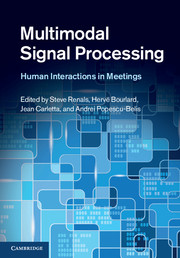Book contents
- Frontmatter
- Contents
- List of contributors
- 1 Multimodal signal processing for meetings: an introduction
- 2 Data collection
- 3 Microphone arrays and beamforming
- 4 Speaker diarization
- 5 Speech recognition
- 6 Sampling techniques for audio-visual tracking and head pose estimation
- 7 Video processing and recognition
- 8 Language structure
- 9 Multimodal analysis of small-group conversational dynamics
- 10 Summarization
- 11 User requirements for meeting support technology
- 12 Meeting browsers and meeting assistants
- 13 Evaluation of meeting support technology
- 14 Conclusion and perspectives
- References
- Index
1 - Multimodal signal processing for meetings: an introduction
Published online by Cambridge University Press: 05 July 2012
- Frontmatter
- Contents
- List of contributors
- 1 Multimodal signal processing for meetings: an introduction
- 2 Data collection
- 3 Microphone arrays and beamforming
- 4 Speaker diarization
- 5 Speech recognition
- 6 Sampling techniques for audio-visual tracking and head pose estimation
- 7 Video processing and recognition
- 8 Language structure
- 9 Multimodal analysis of small-group conversational dynamics
- 10 Summarization
- 11 User requirements for meeting support technology
- 12 Meeting browsers and meeting assistants
- 13 Evaluation of meeting support technology
- 14 Conclusion and perspectives
- References
- Index
Summary
This book is an introduction to multimodal signal processing. In it, we use the goal of building applications that can understand meetings as a way to focus and motivate the processing we describe. Multimodal signal processing takes the outputs of capture devices running at the same time – primarily cameras and microphones, but also electronic whiteboards and pens – and automatically analyzes them to make sense of what is happening in the space being recorded. For instance, these analyses might indicate who spoke, what was said, whether there was an active discussion, and who was dominant in it. These analyses require the capture of multimodal data using a range of signals, followed by a low-level automatic annotation of them, gradually layering up annotation until information that relates to user requirements is extracted.
Multimodal signal processing can be done in real time, that is, fast enough to build applications that influence the group while they are together, or offline – not always but often at higher quality – for later review of what went on. It can also be done for groups that are all together in one space, typically an instrumented meeting room, or for groups that are in different spaces but use technology such as videoconferencing to communicate. The book thus introduces automatic approaches to capturing, processing, and ultimately understanding human interaction in meetings, and describes the state of the art for all technologies involved.
- Type
- Chapter
- Information
- Multimodal Signal ProcessingHuman Interactions in Meetings, pp. 1 - 10Publisher: Cambridge University PressPrint publication year: 2012



